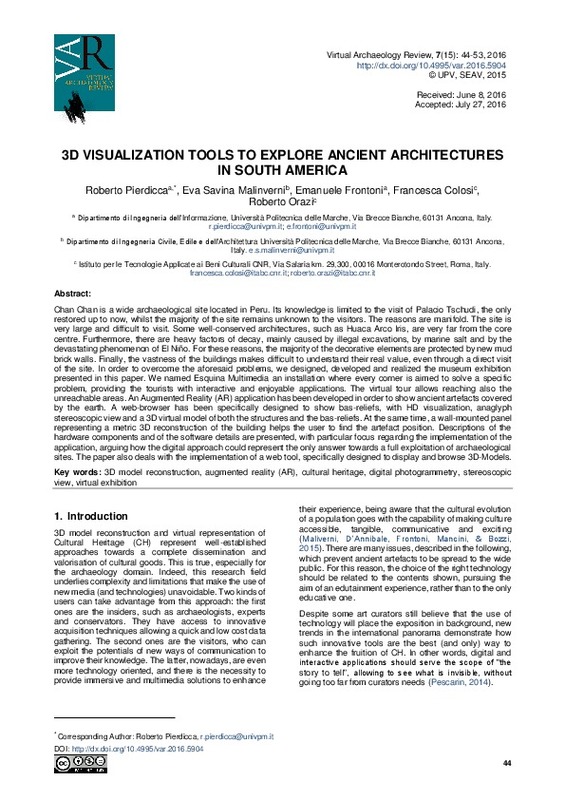JavaScript is disabled for your browser. Some features of this site may not work without it.
Buscar en RiuNet
Listar
Mi cuenta
Estadísticas
Ayuda RiuNet
Admin. UPV
3D visualization tools to explore ancient architectures in South America
Mostrar el registro sencillo del ítem
Ficheros en el ítem
| dc.contributor.author | Pierdicca, Roberto
|
es_ES |
| dc.contributor.author | Malinverni, Eva Savina
|
es_ES |
| dc.contributor.author | Frontoni, Emanuele
|
es_ES |
| dc.contributor.author | Colosi, Francesca
|
es_ES |
| dc.contributor.author | Orazi, Roberto
|
es_ES |
| dc.coverage.spatial | east=-79.07461280000001; north=-8.1055519; name=Huanchaco, Perú | |
| dc.date.accessioned | 2017-05-05T10:18:45Z | |
| dc.date.available | 2017-05-05T10:18:45Z | |
| dc.date.issued | 2016-11-15 | |
| dc.identifier.uri | http://hdl.handle.net/10251/80657 | |
| dc.description.abstract | [EN] Chan Chan is a wide archaeological site located in Peru. Its knowledge is limited to the visit of Palacio Tschudi, the only restored up to now, whilst the majority of the site remains unknown to the visitors. The reasons are manifold. The site is very large and difficult to visit. Some well-conserved architectures, such as Huaca Arco Iris, are very far from the core centre. Furthermore, there are heavy factors of decay, mainly caused by illegal excavations, by marine salt and by the devastating phenomenon of El Niño. For these reasons, the majority of the decorative elements are protected by new mud brick walls. Finally, the vastness of the buildings makes difficult to understand their real value, even through a direct visit of the site. In order to overcome the aforesaid problems, we designed, developed and realized the museum exhibition presented in this paper. We named Esquina Multimedia an installation where every corner is aimed to solve a specific problem, providing the tourists with interactive and enjoyable applications. The virtual tour allows reaching also the unreachable areas. An Augmented Reality (AR) application has been developed in order to show ancient artefacts covered by the earth. A web-browser has been specifically designed to show bas-reliefs, with HD visualization, anaglyph stereoscopic view and a 3D virtual model of both the structures and the bas-reliefs. At the same time, a wall-mounted panel representing a metric 3D reconstruction of the building helps the user to find the artefact position. Descriptions of the hardware components and of the software details are presented, with particular focus regarding the implementation of the application, arguing how the digital approach could represent the only answer towards a full exploitation of archaeological sites. The paper also deals with the implementation of a web tool, specifically designed to display and browse 3D-Models. | es_ES |
| dc.language | Inglés | es_ES |
| dc.publisher | Universitat Politècnica de València | |
| dc.relation.ispartof | Virtual Archaeology Review | |
| dc.rights | Reconocimiento - No comercial - Sin obra derivada (by-nc-nd) | es_ES |
| dc.subject | 3D model reconstruction | es_ES |
| dc.subject | Augmented reality(AR) | es_ES |
| dc.subject | Cultural heritage | es_ES |
| dc.subject | Digital photogrammetry | es_ES |
| dc.subject | Stereoscopic view | es_ES |
| dc.subject | Virtual exhibition | es_ES |
| dc.title | 3D visualization tools to explore ancient architectures in South America | es_ES |
| dc.type | Artículo | es_ES |
| dc.date.updated | 2017-05-05T09:49:41Z | |
| dc.identifier.doi | 10.4995/var.2016.5904 | |
| dc.rights.accessRights | Abierto | es_ES |
| dc.description.bibliographicCitation | Pierdicca, R.; Malinverni, ES.; Frontoni, E.; Colosi, F.; Orazi, R. (2016). 3D visualization tools to explore ancient architectures in South America. Virtual Archaeology Review. 7(15):44-53. https://doi.org/10.4995/var.2016.5904 | es_ES |
| dc.description.accrualMethod | SWORD | es_ES |
| dc.relation.publisherversion | https://doi.org/10.4995/var.2016.5904 | es_ES |
| dc.description.upvformatpinicio | 44 | es_ES |
| dc.description.upvformatpfin | 53 | es_ES |
| dc.type.version | info:eu-repo/semantics/publishedVersion | es_ES |
| dc.description.volume | 7 | |
| dc.description.issue | 15 | |
| dc.identifier.eissn | 1989-9947 |








